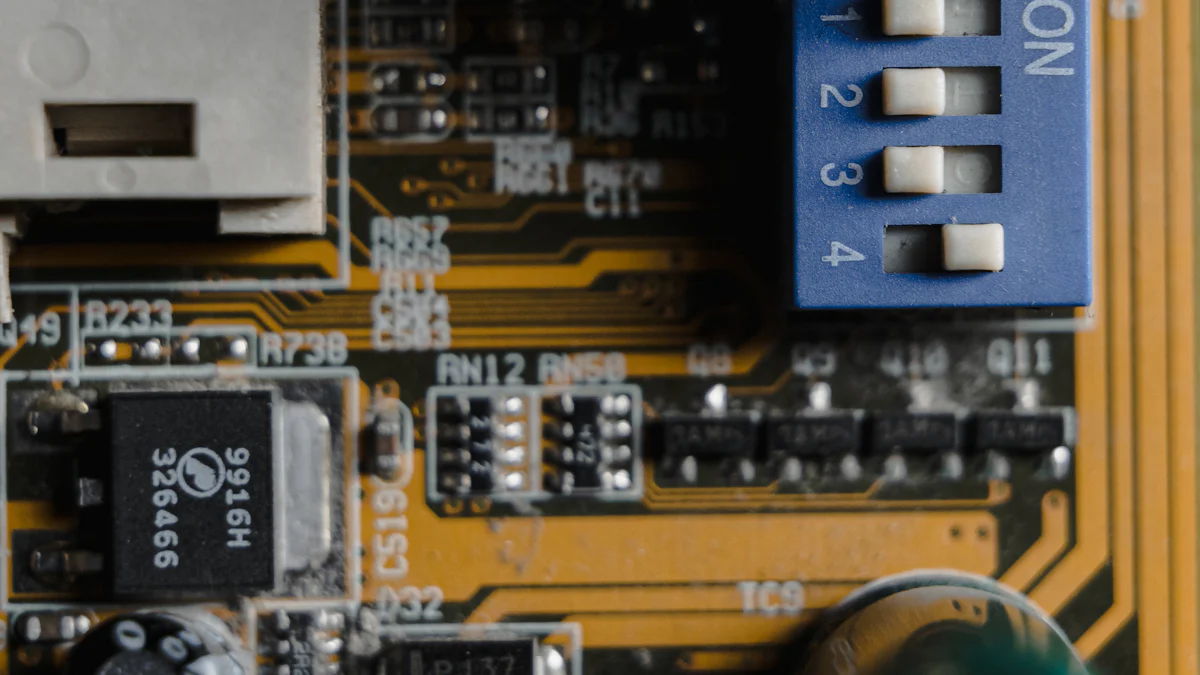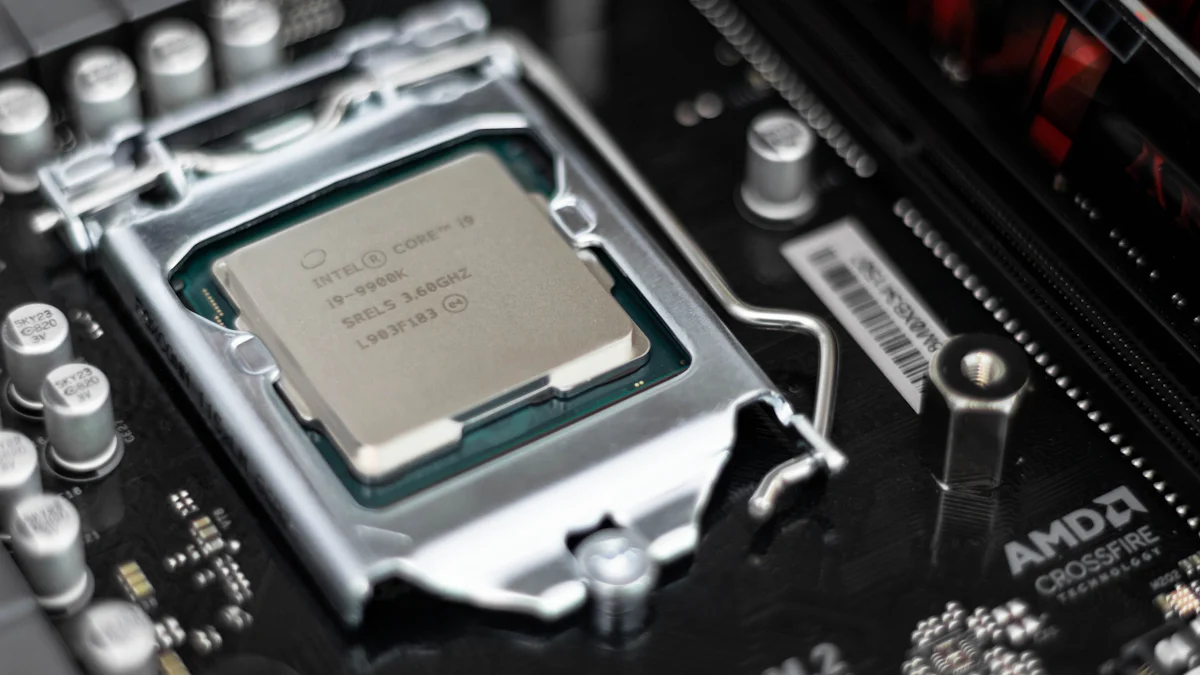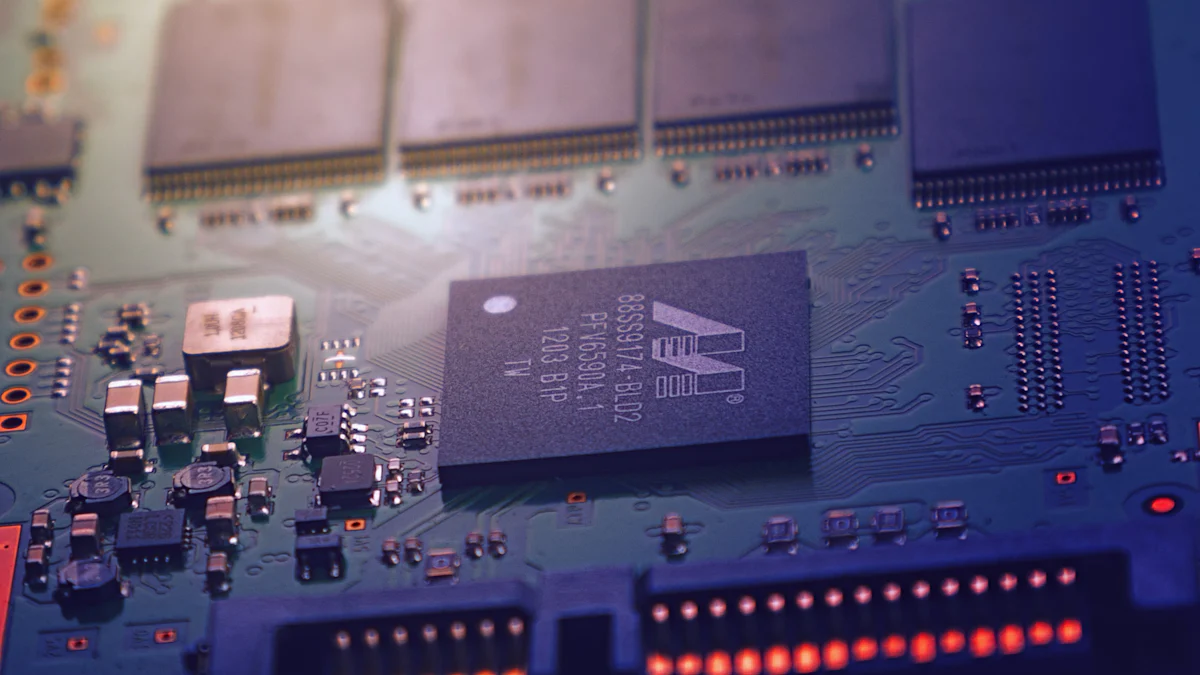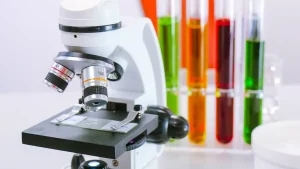
ウェハーキャリアは、半導体製造に不可欠なツールです。デリケートな半導体ウェハーを安全に保持し、搬送するために設計された特殊な容器として機能します。ウェハーの端部を包み込むことで、ハンドリング中の物理的な損傷を防ぎます。また、ウェハーが汚染物質から保護されるように設計されており、クリーンルーム環境では非常に重要です。PTFEテフロンや溶融石英のような材料は、高温や化学薬品に対する耐性を提供し、これらのキャリアを構築するためにしばしば使用されます。このような保護と清浄の組み合わせにより、ウェハーキャリアは高品質の半導体デバイスの製造に不可欠なものとなっています。
要点
- ウェハーキャリアは、製造中の半導体ウェハを物理的な損傷や汚染から保護するために不可欠です。
- PTFEテフロンや溶融石英のような耐久性のある素材で構成されたウェハーキャリアは、清浄性を確保し、過酷な条件にも耐えます。
- FOUPや専用キャリアなど、さまざまなタイプのウェーハキャリアは、特定の製造ニーズに対応し、自動化を強化する。
- ウェーハキャリアは、ウェーハとの直接接触を最小限に抑える設計で、傷のリスクを低減し、高品質の生産を保証します。
- ロボットシステムとの統合により、ウェハキャリアはハンドリングプロセスを合理化し、効率を向上させ、人的ミスを減らします。
- 高品質のウェハーキャリアへの投資は、欠陥を防止し、最適なウェハ状態を確保することで、大幅なコスト削減につながります。
- 半導体技術が進歩するにつれ、ウェハーキャリアは革新的な製造プロセスを支える重要な役割を果たし続けるだろう。
ウェハーキャリアを理解する

定義と目的
ウェハーキャリアは、半導体製造において重要なコンポーネントです。これは、製造の様々な段階を通して半導体ウェハーを保持し、輸送するための安全な容器として機能します。これらのキャリアは、ウェハーを物理的な損傷や汚染から保護し、その完全性が損なわれないように設計されています。ウェハーの端部を保持することで、最終製品の品質を損なう可能性のあるウェハー表面の傷や亀裂を防ぎます。
ウェハーキャリアの目的は、単なる保管にとどまりません。クリーンルーム環境で要求される清浄度の維持に重要な役割を果たしています。半導体ウェハは、パーティクル、水分、その他の不純物に対して非常に敏感です。ウェハーキャリアは、これらの汚染物質を遠ざけるシールドの役割を果たします。さらに、ロボットハンドリングシステムとの互換性により、最新の半導体製造における自動化プロセスをサポートします。この互換性により、異なる製造工程間のスムーズな移行が保証され、ヒューマンエラーのリスクを低減します。
ウェハーキャリアの主な特徴
ウェハーキャリアには、半導体産業で欠かせないいくつかの特徴があります。その主な特徴をいくつか紹介しよう:
素材構成:ほとんどのウェハーキャリアは、PTFEテフロン、溶融石英、ポリプロピレンなどの耐久性のある材料で作られています。これらの材料は高温や化学薬品に耐えるため、半導体製造の過酷な条件に最適です。
安全な保持機構:多くのキャリアは、ウェハーをしっかりと固定する精密成形のスロットや溝を備えています。例えば、ウェーハのエッジを支える円錐形のベースを採用し、ウェーハ表面との接触を最小限に抑えたモデルもあります。
容量とサイズのオプション:ウェハーキャリアは、125mmや300mmなど、さまざまな直径のウェハに対応できるよう、さまざまなサイズが用意されています。1枚のウェハーを収納できるキャリアもあれば、複数枚のウェハーを収納できるキャリアもあり、1つのキャリアに最大25枚のウェハーを収納できます。
カスタマイズ性:各メーカーは、特定のニーズに合わせたカスタムウェハーキャリアを提供しています。これらのキャリアは、調整可能なシリコーンサポートやPVDFや天然ポリプロのような特殊な材料などの機能により、独自のプロセスに最適化することができます。
環境保護:先進的なウェハーキャリアには、管理された環境を作り出すためのシールやロック機構が含まれていることがよくあります。これらの機能により、保管や輸送中のウェハーを埃や湿気、その他の不純物から保護します。
モニタリングのための透明性:多くのキャリアは透明で、作業者は容器を開けずにウェハーを目視検査できます。この機能により、生産中の迅速で効率的なモニタリングが可能になります。
ウェハーキャリアは単なる容器ではありません。ウェハーの安全性と清浄性を確保するために精密に設計されたツールです。考え抜かれた設計と堅牢な機能により、半導体製造プロセスにおいて不可欠なものとなっています。
ウェハーキャリアの種類

ウェハーキャリアには様々なデザインがあり、それぞれが半導体製造における特定のニーズに合わせて作られています。これらのキャリアは、ウェハーの安全性、清潔性、および処理準備を保証します。最も一般的なタイプについて見てみましょう。
オープンカセットウェハーキャリア
オープンカセットウェハーキャリアは、半導体製造に使用される最もシンプルな設計の一つです。これらのキャリアは、ウェハーの端部をしっかりと保持し、手動または自動ハンドリング中に簡単にアクセスできるようにします。オープン構造であるため、軽量でコスト効率に優れています。しかし、この設計では汚染に対する保護は限定的です。ほこりやパーティクルがウェハーに付着しやすく、このキャリアは厳しい清浄度を必要とする環境には適していません。
その限界にもかかわらず、オープン・カセットは特定の用途では依然として人気がある。オープンカセットは、ウェハーに頻繁にアクセスする必要があるプロセスや、コンタミネーションのリスクが最小限の場合に適しています。また、様々なウェハーサイズに対応できることも、汎用性を高めています。
FOUP(フロントオープニングユニファイドポッド)ウェハーキャリア
FOUP(フロント・オープン・ユニファイド・ポッド)は、より高度なタイプのウェーハキャリアです。これらのキャリアは、最新の半導体製造の厳しい要件を満たすように特別に設計されています。FOUPは、パーティクル、湿気、揮発性有機化合物(VOC)などの汚染からウェハーを保護する密閉環境を提供します。そのため、クリーンルーム環境での使用に最適です。
FOUPの際立った特徴の一つは、自動化システムとの統合です。FOUPは、ウェーハのシームレスなローディングとアンローディングを可能にし、手作業の必要性を低減します。FOUPは、先端半導体プロセスで一般的な300mmウェーハに特に適しています。FOUPの堅牢な設計により、ハイテク製造施設においても、ウェハーの搬送・保管時の安全性が確保されます。
「FOUPはウェーハを保護するだけでなく、自動化をサポートすることで生産効率を高める」と業界の専門家は指摘する。
専用ウェハーキャリア
特殊なウェハーキャリアは、ユニークな製造ニーズに対応します。これらのキャリアはしばしば、特定の課題に対処するためのカスタム設計や材料を特徴としています。例えば、PVDFや天然ポリプロピレンのような耐薬品性に優れた素材を使用した特殊キャリアもあります。また、さまざまなサイズのウェハーに対応できるよう、調整可能なサポートを備えているものもあります。
一部の特殊なキャリアは、高温プロセスや腐食性の化学薬品が使用される環境など、過酷な条件に合わせて設計されています。これらのキャリアは、厳しい環境下でもウェハが無傷のまま汚染されないことを保証します。さらに、一部のモデルには、制御された微小環境を作り出し、輸送中や保管中にウェハーをさらに保護する高度なシール機構が含まれています。
特殊ウェハーキャリアは、ニッチなアプリケーションで重要な役割を果たし、標準的なキャリアでは不十分なソリューションを提供します。その適応性により、常に進化し続ける半導体産業において不可欠なツールとなっています。
半導体製造におけるウェハーキャリアの役割
汚染防止
半導体製造において、コンタミネーションは重要な課題である。ほんの小さな粒子でもウェハをダメにし、コストのかかる欠陥につながる可能性があります。ウェハーキャリアは、ウェハーをほこりや湿気、その他の不純物から保護するバリアとして機能します。そのデザインは、ウェハー表面との直接接触を最小限に抑え、傷や汚染のリスクを低減します。多くのキャリアは、管理された環境を作り出す高度な密閉機構を備えており、保管中や輸送中もウェハーを清浄な状態に保ちます。
クリーンルーム環境では厳しい清浄度基準が要求されます。ウェハーキャリアは、これらの条件を維持するために重要な役割を果たします。例えば、PTFEテフロンや溶融石英のような素材は、化学反応や高温に耐性があり、クリーンルームでの使用に最適です。業界の調査によると、ウェハーキャリアは、様々な製造段階を通して、デリケートなウェハーを汚染から守るために不可欠です。不純物の混入を防ぐことで、高品質の半導体デバイスの製造に貢献しています。
自動化システムとの互換性
現代の半導体製造は自動化に大きく依存しています。ウェハーキャリアは、ロボットシステムとシームレスに統合できるように設計されており、生産段階間のスムーズな移行を可能にします。この互換性により、手作業によるハンドリングの必要性が減少し、ヒューマンエラーやウェハ損傷のリスクが低減します。例えば、FOUP(フロント・オープン・ユニファイド・ポッド)は、自動化装置と連動するように特別に設計されており、ウェハーの正確なロードとアンロードを可能にします。
自動化は効率も向上させる。ロボットシステムは、スピードと正確さでウェハーキャリアを扱うことができ、一貫した結果を保証します。300mmウェーハ用のような標準化された設計のウェーハキャリアは、自動化ツールと完全に整合することにより、このプロセスを強化します。業界研究で指摘されているように、これらのキャリアは、先端半導体アプリケーションでますます一般的になっている薄ウェーハの安全な取り扱いと効率的な処理をサポートします。
生産効率の向上
時間と精度がコストに直結する半導体製造において、効率化は非常に重要です。ウェハキャリアは、ウェハのハンドリングと搬送を合理化することで、この効率化に貢献します。その安全な保持機構は損傷を防ぎ、再加工や交換の必要性を低減します。さらに、自動化システムとの互換性により生産がスピードアップされ、メーカーは品質を損なうことなく厳しい納期に対応することができます。
ウェハーキャリアの耐久性も、効率向上に一役買っている。グラファイトのような材料は、優れた熱安定性と機械的強度を提供し、キャリアが製造プロセスの厳しさに耐えることを保証します。この信頼性により、装置の故障やウェーハの損傷によるダウンタイムを最小限に抑えることができます。ウェハーの完全性を維持し、自動化をサポートすることで、ウェハーキャリアはメーカーがオペレーションを最適化し、ペースの速い業界で競争力を維持するのに役立ちます。
「ウェハーキャリアはウェハーを保護するだけでなく、自動化をサポートすることで生産効率を高める」と半導体製造の専門家は強調する。
ウェハー・キャリアが半導体産業に不可欠な理由
先進製造プロセスをサポート
半導体産業は常に進化しており、先進的な製造プロセスが技術革新を牽引しています。ウェハー・キャリアは、こうした進歩を支える極めて重要な役割を担っている。IoT、人工知能、5Gのような技術が成長し続けるにつれ、高性能半導体デバイスへの需要が高まっています。ウェハーキャリアは、ウェハが生産期間中、原始的な状態を維持することを保証し、メーカーが最新の製造の厳しい基準を満たすことを可能にします。
300mmウェーハへのシフトは、先端プロセスにおけるウェーハキャリアの重要性を浮き彫りにしている。このような大型ウェーハにより、メーカーはバッチ当たりにより多くのチップを生産できるようになり、効率が向上し、コストが削減される。しかし、このようなデリケートで大きなウェハーを扱うには、精度が要求されます。300mmウェーハ用に設計されたウェーハキャリアは、必要なサポートと保護を提供し、汚染リスクを最小限に抑え、自動化システム間のスムーズな移行を保証します。
加えて、エレクトロニクスの小型化のトレンドは、メーカーがウェハーキャリアに最先端の材料や設計を採用することを後押ししている。例えば、先進的なグラファイト・ウェハーキャリアは、熱安定性と耐薬品性が向上しており、高温プロセスに最適です。このような技術革新により、ウェハーキャリアは最も要求の厳しい環境下でも信頼性を維持し、デバイスの小型化、高速化、高効率化を推進する業界を支えています。
「1990年代以降のウェハーキャリアの進化は、技術的な要求に応えようとする業界の姿勢を反映している」と業界の専門家は指摘している。
費用対効果と品質の確保
半導体製造において、コストと品質のバランスは極めて重要です。ウェハーキャリアは、このバランス達成に大きく貢献します。ウェハーを損傷や汚染から保護することで、欠陥が発生する可能性を低減します。汚染されたウェハー1枚が複数のチップの損失につながり、生産スケジュールと収益性の両方に影響を及ぼします。ウェハーキャリアはセーフガードとして機能し、各ウェハが最適な状態で次の生産段階に到達することを保証します。
最新の自動ウェーハハンドリングプロセスは、費用対効果をさらに高めます。より厳しい公差で設計されたウェーハキャリアは、ロボットシステムとシームレスに統合され、手作業による介入を軽減します。これにより、生産がスピードアップするだけでなく、ヒューマンエラーも最小限に抑えられ、バッチ間で一貫した品質が実現します。例えば、FOUP(フロントオープニングユニファイドポッド)は、自動化をサポートするために特別に設計されており、効率の最適化を目指すメーカーにとって好ましい選択肢となっています。
規制基準や環境基準もウェハーキャリアの設計や使用に影響を与えます。これらの基準への準拠が技術革新を促し、効果的で持続可能なキャリアを生み出します。PTFEテフロンや溶融石英のような材料は、耐久性を維持しながら、健康と安全に関する規制を満たしています。高品質のウェハーキャリアに投資することで、メーカーは長期的なコスト削減を実現し、急速に成長する業界において競争力を維持することができます。
要約すると、ウェハーキャリアは半導体産業において不可欠なものです。先進的な製造プロセスをサポートし、自動化を強化し、品質を損なうことなくコスト効率を確保します。業界が革新を続ける中、ウェハーキャリアは効率的で信頼性の高い半導体製造の礎であり続けるでしょう。
ウェハーキャリアは、ウェハを汚染や物理的損傷から保護することにより、半導体製造において重要な役割を果たしています。その革新的な設計は、クリーンルーム環境で要求される厳格な清浄度基準をサポートし、ウェハーの原形を保つことを保証します。自動化システムとシームレスに統合することで、ウェハーキャリアは生産効率を高め、エラーを低減します。これらのキャリアは、デリケートなウェハーを保護するだけでなく、半導体技術の進歩にも大きく貢献しています。業界の進化に伴い、ウェハーキャリアはウェハーの品質を維持し、製造プロセスの革新を推進するために不可欠な存在であり続けるでしょう。






